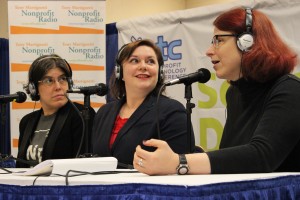
Ananda Robie & Sam Dorman: Your Tech Problem Is Actually A People Problem
Wrapping up our #22NTC coverage, Ananda Robie and Sam Dorman sort out why your nonprofit’s technology problem is very likely a people problem. And they share their roadmap to better technology tomorrow. Ananda is with the Center for Action and Contemplation and Sam is from The Build Tank.


Listen to the podcast
Podcast: Play in new window | Download
Get Nonprofit Radio insider alerts!I love our sponsors!
![]() Turn Two Communications: PR and content for nonprofits. Your story is our mission.
Turn Two Communications: PR and content for nonprofits. Your story is our mission.
Fourth Dimension Technologies: IT Infra In a Box. The Affordable Tech Solution for Nonprofits.
We’re the #1 Podcast for Nonprofits, With 13,000+ Weekly Listeners
Board relations. Fundraising. Volunteer management. Prospect research. Legal compliance. Accounting. Finance. Investments. Donor relations. Public relations. Marketing. Technology. Social media.
Every nonprofit struggles with these issues. Big nonprofits hire experts. The other 95% listen to Tony Martignetti Nonprofit Radio. Trusted experts and leading thinkers join me each week to tackle the tough issues. If you have big dreams but a small budget, you have a home at Tony Martignetti Nonprofit Radio.
View Full Transcript
Processed on: 2022-08-26T19:11:13.159Z
S3 bucket containing transcription results: transcript.results
Link to bucket: s3.console.aws.amazon.com/s3/buckets/transcript.results
Path to JSON: 2022…08…606_tony_martignetti_nonprofit_radio_20220829.mp3.463558328.json
Path to text: transcripts/2022/08/606_tony_martignetti_nonprofit_radio_20220829.txt
[00:02:02.70] spk_0:
and welcome to tony-martignetti non profit radio big non profit ideas for the other 95%. I’m your aptly named host of your favorite abdominal podcast. Oh I’m glad you’re with me. I’d be stricken with cause Elijah if you burned me up with the idea that you missed this week’s show your tech problem is actually a people problem wrapping up our 22 Ntc coverage. Ananda roby and Sam dorman sort out why you’re nonprofits. Technology problem is very likely a people problem and they share their roadmap to better technology tomorrow. Ananda is with the Center for Action and Contemplation and SAM is from the build tank on Tony’s take to wrapping up national make a will month we’re sponsored by turn to communications pr and content for nonprofits. Your story is their mission turn hyphen two dot c o. And by fourth dimension technologies I. T. Infra in a box. The affordable tech solution for nonprofits. tony-dot-M.A.-slash-Pursuant D Just like 3D but they go one dimension deeper. Here is your tech problem is actually a people problem. Welcome to tony-martignetti non profit radio coverage of 22 N. T. C. You know what that is by now through all the interviews we’ve been doing, it’s the 2022 nonprofit technology conference and you know that it’s hosted by N 10. The smart folks who help you use technology as you’re doing your important work with me now are Ananda robi and SAm dorman. Ananda is digital Managing Director of digital products at center for Action and contemplation Sam dorman is co founder At the build tank Ananda Sam welcome to nonprofit radio
Thanks tony [00:02:24.87] spk_2:
Yeah, thank you so much for having us. [00:02:36.99] spk_0:
The pleasure. Pleasure to have both of you. Your session topic is your technology problem is actually a people problem. Sam can you, can you give us an overview of what folks are often, uh, misconstruing about the real problem perhaps at at their smaller, mid sized non profit [00:03:30.65] spk_1:
Yeah, absolutely. Yeah. My partner chris and I, we, you know, founded the bill tank to try to help organizations resolve their pervasive technology pain, which is, um, which is really common. It’s just about every organization is struggling under these, these same restrictions where they just don’t have the technology that allows them to do what they want to do and it’s holding everybody back and it’s creating all all kinds of pain points. And so what I think that people don’t realize is so often it’s not actually a problem with the technology, the symptoms, you know, feel like their problems with technology, but it’s a gap in a certain kind of technology capacity. Um, and it’s about actually getting the right internal team doing the right types of things, which is sometimes not what people expect it should be. And Ananda is a perfect example of that kind of person. And the team she has built at C A C is a perfect example of what it looks like to go from those sorts of pervasive technology Pain points to actually really using leveraging technology to its potential to help increase the organization’s impact [00:03:58.76] spk_0:
ananda what are some of the symptoms that you were you were feeling at center for action and contemplation? [00:04:54.00] spk_2:
Yeah. Well, luckily I was so blessed that by the time I came to the C a C, they had already met chris and SAm and gotten bought in on the digital product team model and investing in structuring technology Well. But prior to coming to see a C in previous roles, I’ve had, I did experience that other nonprofits or in higher ed, which has been my kind of career path. That really what’s most common is you hire folks to do a job and then technology is treated like off the side of their desk. So you might hire a development director who’s responsible for fundraising for your organization, but then they’re also responsible for, you know, keeping the donation platform up and running and troubleshooting issues or if you need a new platform going and finding it and uh, you know, putting it into place. And so it’s just means that people a have too much work on their plate. So their workload is too much and then you don’t have the right people with the right kind of interests and skills doing the work. And so there’s a whole model for how we kind of have distributed ownership and break down the ownership between content folks and technology folks. [00:05:10.36] spk_0:
Okay. You say there’s a whole model, Is that, is that part of what your your session was about? [00:05:51.03] spk_1:
Yeah, exactly. So, so, we, you know, we pulled together this thing called the road map to a better technology tomorrow. So chris and I were always trying to share everything we can as resources. We can work with some organizations like the CDC, but we can’t work with every organization. But it also feels like a lot of these things, once you understand the concepts there not that hard, they’re pretty based on common sense. They’re definitely not common practice, but uh, we try to share everything freely. So we put together this roadmap with just sort of six key steps about, here’s how you go from where you’re, where you are now to building this kind of capacity that’s gonna be able to supercharge you. So, in the, in, in the session, we just walked through those six steps. [00:05:54.01] spk_0:
Okay. And this is the road map to better technology tomorrow. Like something from the 1950s, [00:06:01.43] spk_1:
your [00:06:02.85] spk_0:
new electric stove is the the kitchen of tomorrow for the happy homemaker. [00:06:09.47] spk_1:
We kinda did. It’s a little bit tongue in cheek. We, we like to have a lot of fun with the work that we do. And so we sort of, it felt a little bit like it was like mad men branding the road to a better technology. Yeah, [00:06:37.24] spk_0:
that’s what I think of it immediately, but before we All right. So, we’ll go through the roadmap Sounds, uh, sounds very exploratory what sam, but why why are we defaulting to blaming, uh, faulting technology? Is that, is that because it’s easier than looking introspectively at our team and our skills and gaps there in? Well, [00:06:44.52] spk_1:
it’s hard to [00:06:45.16] spk_0:
blame technology. [00:07:49.02] spk_1:
Well, it’s understandable. That’s where you feel in the pain. So people just don’t have the basic tools that they need. If you’re trying to accomplish anything, you’re trying to, you know, not to use the example of a fundraiser. You’re trying to raise money if you’re a communicator, if you’re a program person, if you’re an executive trying to understand what things are working, the pain point is focused on. We don’t have a system that helps us track our donors well, or understand their journeys with us. Or a lot of pain is felt with websites, you know, like everybody needs to use the website as a key. It’s like your front door. It’s also your engagement pathways. It’s a key property. And very rarely do organizations have it where everybody who has needs with those properties, with those, with those technology platforms, is actually getting those needs addressed. And so, you know, they, that’s where you feel the pain. But what people don’t understand is it’s because there’s a lack of ownership and lack of stewardship and it’s not a highly technical kind of lack of ownership and stewardship that’s missing. It’s a highly strategic, highly communication based set of skills that needed to steward these platforms and make sure that everybody’s getting what they need out of them and have sort of a long term oriented view. It’s exactly the kind of stuff that Ananda is so strong at. [00:08:08.05] spk_0:
Okay, okay, so it sounds like the shortcomings uh manifest themselves in people’s performance because we don’t have the kind of tools we need, you know, the things you ticked off saying that you’re you’re more eloquent in describing that I’m going than I would be, so I’m not gonna bother, but I’ll just say it’s everything you just said, but it manifests itself in poor performance or overworked or [00:08:57.22] spk_1:
Yeah. And I’ll just say, you know, it’s sort of like you have, you you you you wanna you get great people around you in an organization, you have a really inspiring um mission and you get great people around you and it’s like getting a bunch of expert chefs in your kitchen and then all you give them is a bunch of wooden spoons and you say cook a gourmet meal, they just don’t have the tools, they need to make their amazing, you know, and so what you wanna do is you want a situation where you have someone whose job it is to just make const consistently enable their colleagues to do better and greater work via those sort of technology systems. So promise of technology is just not commonly realized for most organizations, it’s just paying up and down the up and down the books [00:09:06.58] spk_0:
because the people at that dining table are gonna say these chefs suck [00:09:10.08] spk_1:
right? [00:09:10.81] spk_0:
Yeah, you’re gonna say something [00:09:12.73] spk_1:
back. [00:09:13.80] spk_0:
I’m sorry. But [00:09:15.34] spk_2:
no, I was just gonna say, I think um [00:09:17.99] spk_0:
when [00:10:12.60] spk_2:
we say it’s a people problem, it’s that’s not to be misconstrued that it’s a problem with the people currently in the organization having a deficit or something. It’s usually a people problem because the right staffing to steward your technology has not been put in place. So it’s really a people problem often in terms of a gap in people for the technology. So it’s a misconstrued notion that, you know, when you get technology, it would be false to think that good technology is just plug and play, you get it off the shelf, you plug it in, you play, it works for your org forever more. Um, that’s not the case for anything. Your organization is growing and developing and adapting and evolving. Um your technology needs to do so as well. But in order to stay on top of that, you have to have the staffing of the folks like me who are responsible for treating that technology almost like a product. So we’re gonna make sure it stays up to date, it gets um serviced and updated and replaced as needed. So I just want to make sure no one is hearing this as it’s a people problem within your org. I’m sure the people within existing orders are phenomenal and they likely have too much to do and a full time job in addition to potentially looking and focusing on technology, you should have a specific stripe within your org that is focused on the technology much like you have stripes focused on your programs. [00:10:40.30] spk_0:
Okay, thank you. Alright, banana. Are you, are you familiar enough with this too to launch our journey on the, on the road map to a better technology tomorrow? [00:10:45.91] spk_2:
Well I’ve had the benefit of truly like working under chris and SAm’s mentorship for the last six years. So I like to think that I’m very familiar [00:10:53.79] spk_0:
with it. [00:10:54.46] spk_2:
Yeah, SAm and I have kind of been on a little bit of a publicity tour lately. I feel like where Sam you know because he and chris is brilliant minds are what came up with the kind of road map and then I get to offer a bit of the color commentary about what it looks like in like implementation and actuality versus [00:12:51.20] spk_0:
theory. Turn to communications media relationships and thought leadership. First comes the relationships then comes the leaderships leadership but I couldn’t pass up the rhyme. You gotta have the relationships before you can get the leadership the thought leadership because you need those relationships so that when an opportunity for thought leadership emerges either because there’s some big news hook or you just have something that is compelling that you need folks to hear. You gotta have uh you gotta have the journalists and the other content creators in a position where they’re gonna pick up the phone when you call, they’re gonna reply when you email. That takes relationships turn to knows how to build those relationships. So you gotta have the relationships, then you can get heard. Then you become a thought leader in your field, turn to communications, they can help you build those relationships. And while you’re working on your messaging, that can help you craft that also so that you become the thought leader, you ought to be, you deserve to be turn to communications. Your story is their mission turned hyphen two dot c o. Now, back to your tech problem is actually a people problem. And what about buying leadership by in Ananda? Was was was was C A C beyond that. When you got there, you said they had already bought in. So, had you, like, had you passed that phase, Is that something you didn’t have to deal with? [00:13:32.75] spk_2:
I mean, I think it’s always ongoing. I’m always telling the stories that it takes to make sure we’re investing in technology properly from a capacity and funding in time perspective. But I really was fortunate when I joined the Sea a sea, that our executive director, Michael Michael Poffenberger had attended one of chris and SAm’s talks and really just connected with their approach to technology and wanted them to support the C A c is really up upping our game when it came to tech. Um but one of chris and SAM’s requirements was that if you want to partner with them, you’ve got to have internal staffing to kind of fill that gap that is all too common when it comes to tech. Um, so hiring my position was basically the organization’s response to this is the direction we’re gonna head when it comes to structuring our technology and this is the first position we’re gonna hire to make that happen. [00:15:11.64] spk_1:
tony maybe I’ll add. It’s also really important to note that a non as part of the leadership team now at C A. C as the chief of this team and that’s one of the things that we really emphasize is important. You know, the actually the first step in the road map we were going to talk about is you must be willing to invest and it’s about investing, not only resources, but time and care and focus. If technology is not part of what your leadership knows and understands, then you’re making decisions sort of devoid of what you can actually do in the world. You know, it’s like technology nowadays as your arms and legs to do almost anything in the world as an organization. And so if you have a bunch of people at leadership level, making decisions about programs and what you’re capable of or timelines or anything like that without that strong back and forth communication with those arms and legs and you have an organization that sort of lurches forward and can’t walk straight. And so it really makes a huge difference when you see a situation like CSC where nana is there as part of the leadership team, able to say yes organization. This is what we’re capable of. And also, um yeah, we can we can do these tradeoffs that we’re talking about at a leadership level, but here’s what we’re gonna have to dip prioritize and here’s what we’re going to prioritize. So it’s just sort of a whole different approach of, of investing in technology is a key skill set for the organization. [00:15:17.61] spk_0:
Okay. And you said that’s our first, our first of the six steps is investing, but not only in the technology, but also in in the organization the people [00:15:48.39] spk_1:
well. And that’s why we start with saying, you have to invest as, you know, you have to be willing to to hire people in this certain type of uh, you know, a certain type of capability and that means salary and that means head count and that’s one of the most expensive things. There are, so a lot of times we say, you know, that’s, you got to hear the bad news first, which is, it’s gonna cost a lot, most organizations are woefully under invested in internally internal technology capacity. And that’s just the truth of it. So when, when people come to us and say, you know, is there an affordable way we can do a B and C. We say no. If you want to be good with your technology and good good meaningful impactful outputs, you have to invest in terms of resources in terms of development, in terms of external experts and in terms of your internal team [00:16:13.51] spk_0:
ananda what what’s the annual budget at Center for Action and Contemplation and and how many employees? [00:16:20.30] spk_2:
Yeah. Great question. I believe our annual budget is close to about nine million and we have about 55 employees. [00:16:35.89] spk_0:
Okay. All right. I want listeners to understand the context of what investment means. Why is at the center for action and shouldn’t contemplation come first and then comes action after you’ve given after you’ve thought about what it is you might be acting on, you [00:16:51.54] spk_2:
know, one of my favorite things that our founder father Richard moore says is that actually the most important word in our title is the word. And because what is good action without sufficient contemplation? And what is the point of contemplation if it doesn’t result in good action? So and is the most important regardless of which order? Those words come in. [00:17:08.97] spk_0:
Okay. All right, thank you. And thank you Father Also. Alright. All right. So, um Sam is there a place for folks who have you know have a smaller organization like uh suppose it’s like half the size of of C a C s annual budget like it’s 4, 4.5 5 million [00:17:22.95] spk_1:
dollars is still [00:17:24.56] spk_0:
a place that that they can improve their relationship. I’m gonna say their relationship with technology. [00:17:31.79] spk_1:
It’s a great question. You know we have done this with very large sort of [00:17:38.48] spk_0:
two great questions in a row. It’s all downhill. Yeah [00:17:39.66] spk_1:
pretty much [00:17:41.58] spk_0:
batting [00:18:54.94] spk_1:
average, batting average is solid so far that we’ve done some very large sort of enterprise scale organizations. We’ve done it with tiny organizations and people ask me that often like well you have to be a certain size and I think the answer is no you don’t have to be a certain size. So I used to work out of an office where there was social enterprises that were being incubated. And so like people starting uh you know, triple bottom line businesses as they used to call them. And what they would do is either the founder uh would be someone with great technical sort of oversight capability or your first hire was sort of a C. T. O. Or a technical co founder. And so nowadays it scales down to I think the size of two, if your organization has a headcount to half of that capacity is probably focused on your technology because anyone starting an organization today understands how essential that is to be able to do anything in the modern day world. The problem is a lot of old organizations are trying to get away from this really old model of like the tech person in the back corner who just thinks of all things tech and everything. Tech goes through that person. We often say that’s like having a department of paper where everything on paper goes through one person in the back room. It just doesn’t make any sense. Everything is technology at these days and you have to be more sophisticated about what who you’re putting on what there’s a lot of different skill sets that you need at the table. Most organizations have their traditional I. T. Covered. Most organizations have their super users of technology covered. And almost no organizations have this particular gap which is technology stewardship [00:19:15.10] spk_0:
Amanda. What were your credentials before you came to see A. C. [00:19:55.68] spk_2:
Yeah so I um I actually studied film in college and I think that’s really comes from, I had an inkling towards technology. I really loved editing, I loved editing software and afterwards I went to work for a nonprofit. My goal was to actually be in the creative team. But but as a part of working there, a part of my job was using salesforce. Um And I was kind of what is traditionally called an accidental admin. So using salesforce for a couple of years they’re like, hey you’re really good at this, Would you be interested in doing this more full time learning more, taking on more responsibility. Um And I said yes and I think it’s one of the best decisions I ever made. Unfortunately our nonprofit went through a pretty massive downsizing. Um So they kind of kept on people who were like the jack of all trades and could do a lot. So I was kept on kept on as primarily the technologist but I’ve been working in Salesforce now for about [00:20:16.08] spk_0:
12 [00:20:16.66] spk_2:
years. Uh So now certified Salesforce admin and focus on our digital product team. So I oversee our Crm Web and I. T. Teams for the C. A. [00:20:24.93] spk_0:
C. [00:21:30.54] spk_1:
Maybe tony I might add that. It’s like a perfect background. So you know one of the things we say is when you’re looking for technology people a lot of people think that means oh we gotta we gotta hire a bunch of developers um And that’s usually the worst thing you can do. Usually development is something that’s not easy um to hire for to manage to to evaluate the quality of work. And it’s one of the best things that you can outsource because there are firms that that’s their job, that’s what they do, that’s what their specialty is. But this sort of this sort of skill set that Ananda is such a master of this sort of like this communication based sort of ally ship based strategic layer of technology stewardship that comes from all all kinds of backgrounds and so oftentimes in an organization, people already have people like this that could be amazing stewards of their technology but they’re just not tapped for that, They’re not put in the right roles. So it really is, it really opens the floodgates for who can come in and help as opposed to sort of competing for the same highly technical, um, you know, people with, with, with depth in a, in a technical area. You’re really looking for people who are just, you know, great communicators and understanding of the big picture and allies, natural allies and uh for for their colleagues to help them do everything they do better. [00:21:55.43] spk_0:
I think big picture big picture technologist is is valuable the way you, the way you described it. Let’s let’s move on to our let’s continue on our journey. Sam what you and your partner have, uh, what’s your next, what our next stop? What’s our next stop on the [00:22:40.26] spk_1:
journey? We’ve already been hopping around in a few of these and you can, you can see them on on the road map. But I’ll mention one piece that Ananda referred to earlier, which is this, this we have this model of trying to separate out the just because of a chart we we created long ago, it was the Blue team and the gold team. The Blue team was this sort of tool. Optimizers like Ananda and the gold team was the people who are trying to use their tools to accomplish their work. So most, most of the people on our chart an organization, they might be like fundraisers communicators, program. People, executives, any number of things. They need tools but they need them to accomplish their work. And like said what often happens is they don’t have the tools they need. So they sort of finally go out and they’re like, I’m gonna build a Crm or I’m gonna build us a new website [00:22:49.66] spk_0:
and [00:23:02.20] spk_1:
now they’re on the phone with developers and talking about platforms and all the stuff that pulls them out of what their strength is instead of work focusing on their areas of expertise, which could be fundraising or anything else. And you’ve got these other people like who are just natural tool optimizers who can sit down with those people here, what they’re trying to do and say, okay, I can go figure out how we do that in technology land. Let me spend all my time on all these crazy paths that that takes. And then we come back together, have a meeting and I can tell you the three options and we go from there. So it’s it allows people to focus on their areas of expertise and and when you see that all of a sudden the machine really starts humming a lot more. [00:23:32.29] spk_0:
So uh summarize the second stop for us. How would you, I mean if if the first one was invest, nothing has to be a single word. I don’t [00:23:59.21] spk_1:
know that’s fine. The second one is differentiate three key areas of technology. So that’s where I was talking about, not just the sort of everything goes through tech but you’ve got traditional I. T. Which is something else which is setting up your computer’s security and software and hardware and all that. That’s a different set of skills. You’ve got your content users, your your super users and then you’ve got the the team that Ananda leads which is actually your your tool optimizer team, your digital product team [00:24:09.47] spk_0:
stewardship to you call technology stewardship [00:24:12.73] spk_1:
technology stewardship. Exactly. [00:24:14.58] spk_0:
Alright. [00:24:45.49] spk_2:
Yeah. I think one of the um you know chris and SAm have a great one liner that I always love to mention when we’re talking about this part of the road map which is that everyone likes to geek out somewhere. And I think that’s the importance here is like are the folks that you have hired within your organization able to focus the majority of their job on what they were hired to do that they’re likely experts and excellent in or are they getting distracted by having to work on tech or technical people having to contribute more to content. So the idea is making sure that folks who like to geek out on development or marketing or creative customer service program execution really get a partner that then is responsible for making sure that we find and build and train on, allowing them to have the best tools possible to do their jobs well. Um and that will just alleviate a lot of dysfunction and a lot of missed opportunity for um, just prioritizing capacity. [00:28:50.81] spk_0:
It’s time for a break. 4th dimension technologies. They still have the free offer exclusively for nonprofit radio listeners. You get the complimentary 24/7 monitoring of your IT assets. It lasts for three months. They’ll be monitoring your servers, your network and your cloud performance. They’ll monitor your backup performance as well all 24 7. If there are any issues, they will let you know ASAP at the end of the three months, you’ll get a comprehensive report telling you how all of this is doing against different benchmarks that are standard. You know, you want to know how you’re, how you’re faring compared to where you ought to be faring. And they promised to throw in a few surprises as well. It’s all complementary. It’s on the listener landing page, tony-dot-M.A.-slash-Pursuant D just like three D. But they go one dimension deeper. It’s time for Tony to take two national maker will month is coming to an end. So sad. But I am celebrating to the bitter end. We’re not letting any of national make a will month go away, leave us without full celebration. And to that end I’ve got more ideas, more reasons really. They’re not just there. They are. My ideas, they’re my thinking. But these are, these are reasons, this is not in the abstract reasons why wills are the place to start your plan to giving, I’ve done 13 through 15 already. I’m gonna do 15 through 13 through 15 already. I’m gonna do 16, 17 and 18, the last week of August and you can see the compendium of reasons at linkedin so far. Eventually they’ll be on my blog. But right now you go to linkedin through the month of august, you will see the cornucopia of reasons why planned giving should be started with Will’s simple charitable bequests. So go to my linkedin and you will see the vast array of reasons That is Tony’s take two. We’ve got just about a butt load more time for your tech problem is actually a people problem with ananda roby and sam dorman. I’m thinking about fundraising, which is what I do. I do plan giving fundraising consulting and thinking about how the supplies and fundraising, like there are people who are great at relationships but not so good about the simple, the simple, very simple user task of documenting the relationships and the activity and the steps and things. So, you know, like for them, if there could be some smoother way, like maybe they could dictate instead of having to type or you know, maybe give them a portable device, you know, they can, they can do it on a, on a on a pad or a service, you know, instead of having to carry their laptop or feel like they have to go back to their desktop to to preserve things like that. I think that’s a simple example. It’s a [00:29:20.61] spk_2:
simple example but it’s perfect. I mean that’s the epitome of my job is like what do you need to do in order to do your job well and if one of those things is documenting your interactions and there seems to be a roadblock to doing that well let’s find out why is it like that you are constantly maybe out in the field doing your work and there’s not a good mobile app in order to complete that. So you’re having to wait till you get back to your desk is the platform, you’re using the UX UI really clunky to use are you just not trained? Have we now not provided the reporting that then shows the return on your investment. So you have this incentive to see how all of your work is paying off. There’s not necessarily a single or simple answer. So the trick is understanding the need and the reason and the why behind that need, understanding what the roadblock is and then alleviating that and that’s different for different people, some people that might be a technology use equal issue and other people that might be not understanding the need or the reward behind doing it [00:29:49.06] spk_0:
well [00:30:16.31] spk_1:
so well said and you know when you hear a non to talk, you can just imagine the power of having a colleague like that who’s just sort of a heat seeking missile for problem solving and knocking knocking hurdles out of people’s way. It’s completely flips the sort of traditional dynamic that you have for technology which is if you got a problem submit a ticket and we’ll get to it when we can, you know, that’s like the opposite of what anna and her team are doing. They’re out there being like tony your we you know, you’re out there trying to fundraise for us. We want you to succeed your our colleague, your ally. Like how can we help you do that better? And what you find is that once people realize they have that kind of a team on board, those sort of that kind of allies in place. The ideas just come fast and furious and then the R. O. I. Just sort of spikes where all of a sudden everybody is more powerful and more effective with the hours in their day, the R. O. I. And it’s just unbelievable. But it starts with that upfront investment [00:30:48.00] spk_0:
see all right, continue us on the road map. [00:31:53.81] spk_1:
Well yeah, we’ve been getting a lot of this. So we differentiate those areas of technology, you build this team, a technology accelerator team or a digital product team like talked about and then it’s all about hiring the right kinds of people which we’ve talked about that sort of strategic stewardship level layer and then one thing we didn’t talk about is insourcing and outsourcing the right things. I did mention this idea that you don’t want to generally in source uh development, you want to hire, you want to work with external partners. Actually, the last step of our road map, we call make magic with external partners. And even though that’s sort of flowery language, we chose that on purpose because when you have the right dynamic, you have, you know, sort of a superhero internally, like Ananda working with a really skilled external developer or external firm giving sort of depth of strategic and technical expertise. Well that will take us on a certain, you know, certain type of work that they’re doing, but also for their, for their web work. They working with a terrific web firm and for their Crm work, they’re working with a terrific crm firm and not just, you know, the traditional thing is just handing the work out to somebody and then they do whatever they do and they deliver it and good luck. And on day one, you know, you figure out whether you can use it or not, it’s the opposite of that. It’s, it’s very much an ongoing partnership, just probably not to talk about this because that’s where you see a lot of the power, it’s not about building a team internally, that’s going to do everything, It’s about building a team that’s going to steward it, figure out who are the right players that you need on the field. [00:33:53.49] spk_2:
Yeah, I think often like this part of what the roadmap that we talk about can be very surprising to folks, especially if you’re saying like, hey build a technology team and the first thing is maybe not to hire like an extra under the hood. Super incredible. 10 times certified developer. Um that’s not what we would look for as the first hire doesn’t mean you’re not going to grow and expand into meeting that kind of expertise within your org um but for me, technical knowledge is one of the easiest things to learn and like SaM said the contract for so yeah, what we want to ensure we’re not doing is outsourcing the brains because if you do that then you really risk making bad investments and bad prioritization so you might be doing the wrong work or not actually getting at the root of what’s needed because truly like no one has better knowledge of the needs and nuances and changes of your organization than someone internally. So you need someone internally who is truly tasked with owning and stewarding, you know, the strategy, technical work and investments for your platform. The way that we do that is like, you know, we do all of our own admin work inside and then we have a phenomenal partner for our sales force team that if we need any coding or high level development, there’s not enough of that work for us to need to staff a full time position, but we have a great partner that we can outsource that work to um but again, like sam saying it’s not just an outsourcing, we don’t have a partner that’s just an order taker. They’re not just like, yes, we’ll do it. They really come to the table and we expect and ask of them to bring their wisdom and their critical thinking and their partnership so that they up our game, so they’re just not execute ear’s, they’re actually asking questions and giving advice about how we’re investing in our technology as well. So we get an additional phenomenal external partner on our [00:34:18.62] spk_0:
work. And I can see why you said earlier that you’re constantly making the case for a particular technology investment, you know, what’s the, what’s the return gonna be, how is this gonna improve our efficiency? You know, I can see how your regularly making this case these cases all [00:34:47.30] spk_2:
the time. Yeah. You know, and we started with moving the air, creating a Crm team internally and advocating for this type of investment on crm structuring the team in this way, finding the external partners in, you know, replacing old platforms that were not performing well with newer technology. Um, and then a few years down the road, you know, went back to chris and SAm, I think our executive director went back and said, hey, we’re experiencing a lot of pain on the web, like what’s going on over here, and they’re like, it’s the same issue you’ve got to treat and staff your web technology like you have crm. So we’ve brought web into the fold and made the same kind of advocacy and same kind of investment for internal staffing, Internal stewardship and external partners. [00:36:03.20] spk_1:
Yeah. And you know, Tony. I think you see the same sort of like when there’s pain, there’s turf penis because people are just fighting to get the basics of what they need to do their work. So they say, no, this is ours, we’re gonna hold on to this is, you know, I had to go build a new web site. So I’m gonna hold onto this with everything I got, once you have a team like Ananda hired this amazing uh, product manager for web jesse jones. Once Jessie’s in there, people are only too happy to sort of let go of control because they know that she is gonna look out for their needs and do it 10 times better than they could have done it themselves. And meanwhile they get to do their fundraising or communications or program work and focus on that. So it’s just this process of getting everybody optimized onto the skills that they are best suited for and the things they love to wake up in the morning and geek out on, you know, what better option is there, that one, you’ve got the tools all that, that you need and two, you get to do the work, you’re excited about with them. It’s, you know, a lot of it is common sense, but it’s about bringing the right types of people in [00:36:28.82] spk_0:
ananda? What have we not talked about yet that you want folks to know about this the process or the investment maybe questions that came during your session that you think are were valuable. [00:36:33.03] spk_2:
Yeah let’s see what have we not covered yet. We’ve covered a lot. [00:36:38.04] spk_0:
Well non profit radio is a comprehensive podcast. I hope I hope you’re not surprised by that. [00:36:43.06] spk_2:
I expected nothing less. [00:36:44.64] spk_0:
Thank you very much. Thank you that’s the validation I’m looking for. Thank [00:36:48.60] spk_1:
you very [00:36:49.47] spk_0:
important to me it’s very important [00:37:59.95] spk_2:
um I would just say I think the only other thing that um I have discovered in my work here that um is important is often people can start conflating um digital product team members with more like traditional I. T. And so one of the things that has become important about my role is really protecting my team’s time in their remit so often you know when you put these really ally oriented folks onto your staff and they start fixing all of these pain points or debacles and make things run smoothly and get improved and partner with your gold team members, your content members. Um you can start to develop a reputation as almost like a fixer and so one of the things is then all of a sudden you’re getting all kinds of questions like hey can you fix this printer, can you work on my computer, Can you do this? So I think you know we touched on it earlier about the three different areas of technology but really keeping that distinction and not letting you know I. T. And digital products kind of become one in people’s minds because then all of a sudden you have folks who re we have the potential to be force multipliers for your organization whose time ends up getting eaten up by you know fixing that are important but they’re not really what the remit of this [00:38:14.17] spk_0:
exactly [00:38:24.51] spk_2:
which is so important if you need to print that’s important to your job. But that’s not a force multiplication for the productive nous. And the mission of your organization said it’s a different skill set and they should be treated and maintained separately. [00:38:34.04] spk_0:
Sam same question for you. Anything you’d like to uh I’d like to add that we haven’t talked about yet. [00:39:26.23] spk_1:
No it indeed it has been very comprehensive and I appreciate the time to talk about it. I guess I would just say um that the the this path is very possible. Organizations can make this transition and like we say it there’s no shortcut you have to put in the time to focus on the resources you have to care enough uh to really invest and to invest in all those ways but you can walk down this path that’s why we’ve tried to share these resources as as openly as we have. It’s all there like the bill tank dot com slash roadmap you can read through it. Um it’s just about the sort of common sense of things are not going to be great unless you have great people stewarding them, just like every area of your organization. So I guess the thing I want to, I just want to offer some hope to people who are struggling under the burden of systems that hold them back instead of supercharge them that it is possible, you know, it’s not possible without investment but with the right investment in the right structures it is possible that everybody has the tools they need to work more effectively to be more happy at their work, to be more effective at the end of the day and to have more impact [00:39:46.44] spk_0:
and you’ll find the resource at the build tank dot com slash resource map source roadmap of course that’s roadmap. The build tank build tank dot com slash [00:39:58.45] spk_1:
roadmap which [00:40:00.13] spk_0:
is the roadmap to better technology tomorrow for our happy homemakers [00:40:04.77] spk_1:
19 [00:40:11.24] spk_0:
50s. Alright, that’s Sam Dorman, he’s co founder at the build tank and also Ananda robi, managing Director of digital Products at Center for Action and Contemplation. Ananda SAm thank you very very much for sharing. Thanks [00:40:22.10] spk_1:
tony [00:40:24.06] spk_2:
pleasure, [00:41:45.33] spk_0:
thank you and thank you listeners for being with tony-martignetti non profit radio coverage of 22 N. T. C. Next week. We now return to our regularly scheduled non 22 N. T. C. Programming principles of sustained fundraising with larry johnson. If you missed any part of this week’s show, I Beseech you find it at tony-martignetti dot com. We’re sponsored by turn to communications pr and content for nonprofits. Your story is their mission turn hyphen two dot C o and by fourth dimension technologies Yes, I Tion for in a box, the affordable tech solution for non profits but also get the free offer, the listener offer all of its at tony-dot-M.A.-slash-Pursuant four D. You know, just like three D. But they go one dimension deeper. Our creative producer is Claire Meyerhoff shows, social media is by Susan Chavez. Marc Silverman is our web guy and this music is by scott stein, thank you for that. Affirmation Scottie with me next week for nonprofit radio big non profit ideas for the other 95% go out and be great






 “Capacity” means nothing until we unlock what kind. Technical? Managerial? Fundraising? Board? Steve Heye with
“Capacity” means nothing until we unlock what kind. Technical? Managerial? Fundraising? Board? Steve Heye with 








